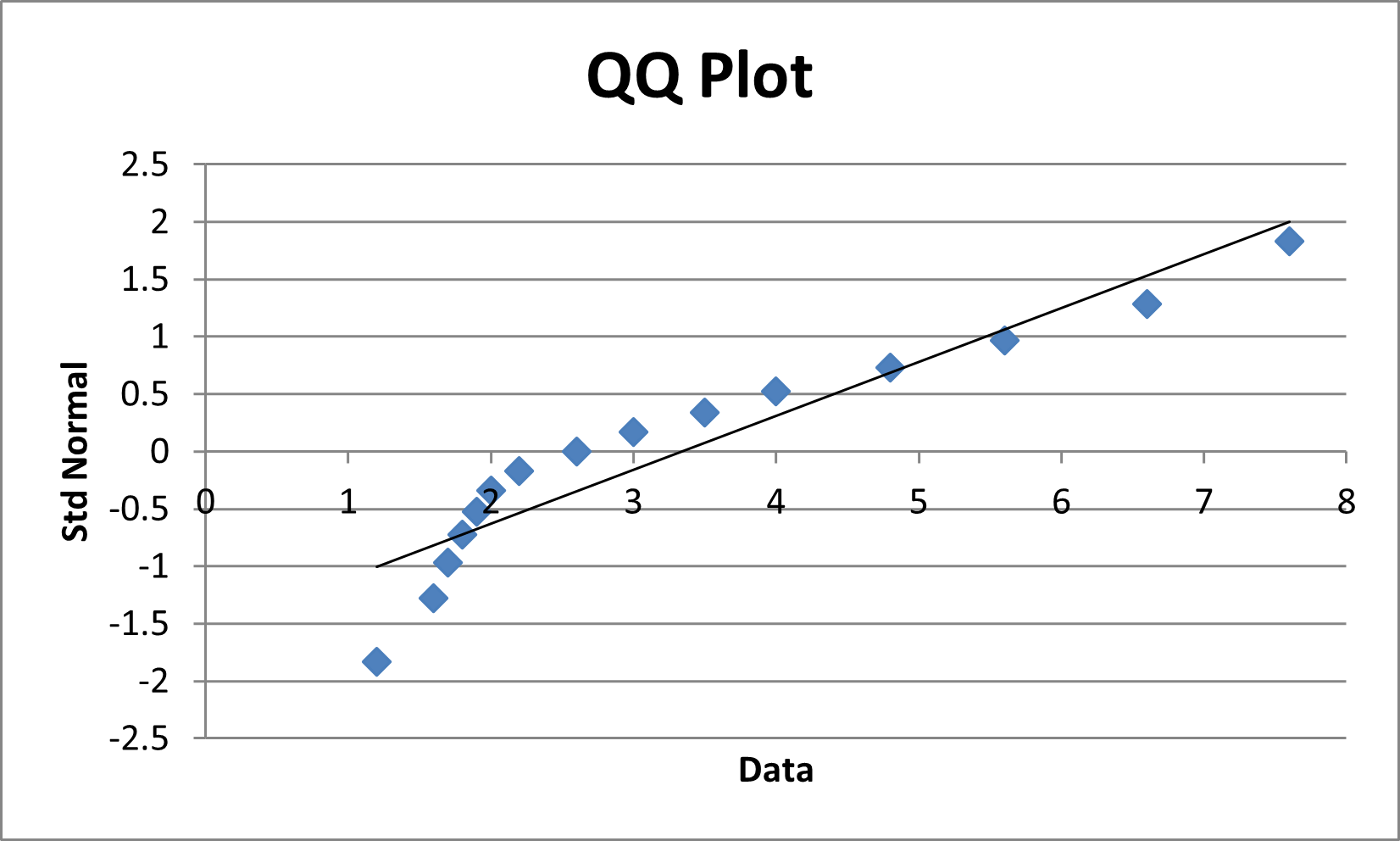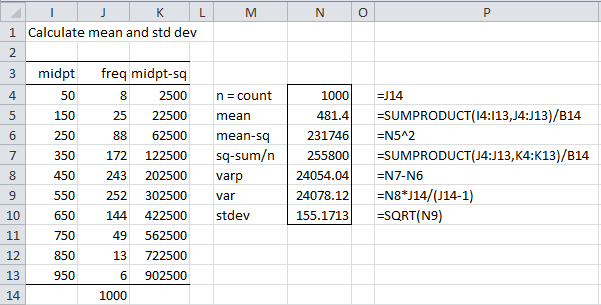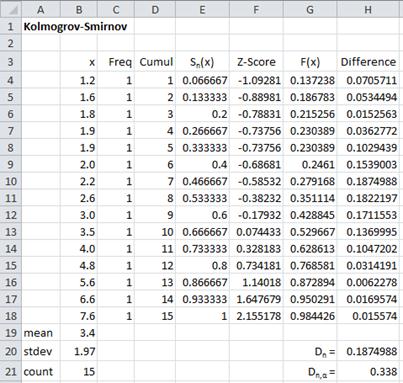Hypothesis Testing
Definition 1: Let x1,…,xn be an ordered sample with x1 ≤ … ≤ xn and define Sn(x) as follows:
Now suppose that the sample comes from a population with cumulative distribution function F(x) and define Dn as follows:
Observation: It can be shown that Dn doesn’t depend on F. Since Sn(x) depends on the sample chosen, Dn is a random variable. Our objective is to use Dn as a way of estimating F(x).
Critical Values
The distribution of Dn can be calculated (see Kolmogorov Distribution), but for our purposes now the important aspect of this distribution is the table of critical values. These can be found in the Kolmogorov-Smirnov Table.
If Dn,α is the critical value from the table, then P(Dn ≤ Dn,α) = 1 – α. Dn can be used to test the hypothesis that a random sample came from a population with a specific distribution function F(x). If
then the sample data is a good fit with F(x).
Confidence Interval
Also from the definition of Dn given above, it follows that
![]()
Thus Sn(x) ± Dn,α provides a confidence interval for F(x)
Examples (Frequency Table)
Example 1: Determine whether the data represented in the following frequency table is normally distributed where x represents rainfall amounts.
Figure 1 – Frequency table for Example 1
This means that 8 elements have an x value less than 100 (i.e. between 0 and 100), 25 elements have an x value between 101 and 200, etc. We need to find the mean and standard deviation of this data. Since this is a frequency table, we can’t simply use Excel’s AVERAGE and STDEV functions. Instead, we first use the midpoints of each interval and then use an approach similar to that described in Frequency Tables as shown in Figure 2:
Figure 2 – Calculating mean and standard deviation
Thus, the mean is 481.4 and the standard deviation is 155.2. We can now build the table that allows us to carry out the KS test, as shown in Figure 3.
Figure 3 – Kolmogorov-Smirnov test for Example 1
Columns A and B contain the data from the original frequency table. Column C contains the corresponding cumulative frequency values and column D simply divides these values by the sample size (n = 1000) to yield the cumulative distribution function Sn(x)
Column E uses the mean and standard deviation calculated previously to standardize the values of x from column A. E.g. the formula in cell E4 is =STANDARDIZE(A4,N$5,N$10), where cell N5 contains the mean and cell N10 contains the standard deviation (from Figure 2). Column F uses these standardized values to calculate the cumulative distribution function values assuming that the original data is normally distributed. E.g. cell F4 contains the formula =NORM.S.DIST(E4,TRUE). Finally, column G contains the absolute values of the differences between the values in columns D and F. E.g. cell G4 contains the formula =ABS(F4—D4). If the original data is normally distributed these differences will be zero.
Test Results
Now Dn = the largest value in column G, i.e. MAX(G4:G13) = 0.0117 (cell G8). If the data is normally distributed then the critical value Dn,α will be larger than Dn. From the Kolmogorov-Smirnov Table we see that
Dn,α = D1000,.05 = 1.36 / SQRT(1000) = 0.043007
Since Dn = 0.0117 < 0.043007 = Dn,α, we conclude that the data is a good fit for the normal distribution.
Example (Raw Data)
Example 2: Using the KS test, determine whether the data in Example 1 of Graphical Tests for Normality and Symmetry is normally distributed.
We follow the same procedure as in the previous example to obtain the results shown in Figure 4. Since the frequencies are all 1, this example might be a little easier to understand.
Figure 4 – KS test for data from Example 2
The Kolmogorov-Smirnov Table shows that the critical value Dn,α = D15,.05 = .338.
Since Dn = 0.1874988 < 0.338 = Dn,α, we conclude that the data is a reasonably good fit with the normal distribution. This is inconsistent with the QQ plot shown in Figure 5, which seems to show that the data is not normally distributed.

Figure 5 – QQ Plot for Example 2
The reason for this inconsistency is that the Kolmogorov-Smirnov test in the form presented above is only valid when the population mean and standard deviation are known, and not estimated from the sample. In the case where the population mean and standard deviation are not known, you need to use the Lilliefors version of the test, as described below.
Worksheet Functions
Real Statistics Functions: The following functions are provided in the Real Statistics Resource Pack:
KSCRIT(n, α, tails, interp) = the critical value of the Kolmogorov-Smirnov test for a sample of size n, for the given value of alpha (default = .05) and tails = 1 (one tail) or 2 (two tails, default), based on the KS Table. If interp = TRUE (default) then the recommended interpolation is used; otherwise, linear interpolation is used.
KSPROB(x, n, tails, iter, interp, txt) = an approximate p-value for the KS test for the Dn value equal to x for a sample of size n and tails = 1 (one tail) or 2 (two tails, default) based on a linear interpolation (if interp = FALSE) or recommended interpolation (if interp = TRUE, default) of the values in the Kolmogorov-Smirnov Table, using iter number of iterations (default = 40).
Note that the values for α in the Kolmogorov-Smirnov Table range from .001 to .2 (for tails = 2) and .0005 to .1 for tails = 1. When txt = FALSE (default), if the p-value is less than .001 (tails = 2) or .0005 (tails = 1) then the p-value is given as 0, and if the p-value is greater than .2 (tails = 2) or .1 (tails = 1) then the p-value is given as 1. When txt = TRUE, then the output takes the form “< .001”, “< .0005”, “> .2” or “> .1”.
For Example 2, KSCRIT(15, .05, 2) = .338 (the same as shown in cell H21 of Figure 4). Also note that the p-value = KSPROB(H20, B21) = KSPROB(0.184177, 15) = 1 (meaning that p-value > .2), and so once again we can’t reject the null hypothesis that the data is normally distributed.
If the value of Dn had been .35 in Example 2, then Dn = .35 > .338 = Dcrit, and so we would have rejected the null hypothesis that the data is normally distributed. In this case, we would have seen that p-value = KSPROB(.35,15) = .0427, which once again leads us to reject the null hypothesis.
Kolmogorov Distribution
As referenced above, the Kolmogorov distribution can be useful in conducting the Kolmogorov-Smirnov test. Click here for more information about this distribution, including some useful functions provided by the Real Statistics Resource Pack.
Lilliefors Test
When the population mean and standard deviation for the Kolmogorov-Smirnov Test is estimated from the sample mean and standard deviation, as was done in Example 1 and 2, then the Kolmogorov-Smirnov Table yields results that are too conservative. More accurate results can be derived from the Liiliefors Table as described in the Lilliefors Test for Normality.
References
National Institute of Standards and Technology NIST (2021) Kolmogorov-Smirnov goodness-of-fit test
https://www.itl.nist.gov/div898/handbook/eda/section3/eda35g.htm
Wikipedia (2012) Kolmogorov-Smirnov test
https://en.wikipedia.org/wiki/Kolmogorov%E2%80%93Smirnov_test




Where is this test located in your Real Statistics package? Thank you.
Hi Charles,
I think the Kolgomorov-Smirnov test for normality testing may be more suitable than other options for my data raw data that I have arranged in a single column R.
Using the functions: =@KSSTAT(R1:R1000), =@LPROB(A1,SUM(R1:R1000),,,,TRUE), =@LCRIT(A2,0.05,2,TRUE), cell A1 contains the output of the first function (i.e. KS stat) and A2 contains the n.
It seems to me that the data needs to be sorted in ascending order for this. Is that correct? I’ve not seen it explicitly stated that the data must be arranged as such but it seems that this may be the case from from the example data tables provided.
Can you please clarify this for me?
Thank you in advance.
Hello Gareth,
Yes, the data must be sorted.
Charles
It looks like the data-set shown in Figure 2 is not the same as the data-set shown in Figure 3, i.e., their means are different etc. This makes the subsequent calculations somewhat more difficult to follow.
Hello Adrian,
I can see that there may be some confusion, but the values in column A of Figure 3 represent ranges of x values: 0 to 100, 101 to 200, etc. You should use the means from Figure 2.
Charles
What is the symbol used while mentioning the value of KS test calculated via SPSS? Is ‘KS-Z’ correct?
Hello Prachi,
Sorry, but I don-t use SPSS and so am unable to answer your question. This website is about statistical analysis, including the KS test, using Excel.
Charles
Thank you Sir for a great article
If I want to fit-test a weibull distribution, do I just change the value of cdf function for weibull instead of normal (in the F(x) column) ?
thank you for comment
greeting from Indonesia
Yes, this is correct. See https://www.real-statistics.com/non-parametric-tests/goodness-of-fit-tests/one-sample-kolmogorov-smirnov-test/
See also an alternative test at https://www.real-statistics.com/non-parametric-tests/goodness-of-fit-tests/anderson-darling-test/
Charles